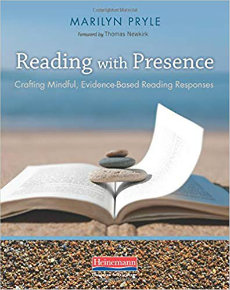Help Students Craft Mindful Class Responses
Reading with Presence: Crafting Mindful, Evidence-Based Reading Responses
By Marilyn Pryle
(Heinemann, 2018 – Learn more)

Does this scenario sound familiar? You know your students have read the material, but when they are put on the spot to answer a question or make a comment on the text, you are greeted with blank stares. Help is on the way!

Because she remembers her own experiences as a young learner, she designed a system of writing short reading responses (RRs) for and with her students. She gives her students an opportunity to organize their thoughts, reactions, opinions, and/or questions in writing, so they are prepared to participate in class discussions.
A big picture view of Reading Responses
In Part One, Reading Responses as Classroom Practice, the author provides the reader with a big picture view of her reading response system. Her goal is for students to contribute to discussions, not just find the answer. With that goal in mind, Pryle’s students engage with the text and can be wrong, can pull in their personal experiences, and can even ask “dumb questions.” Pryle calls this kind of engagement “reading with presence.” (p.8)
It is a simple process to implement that results in deeper understanding of the text. The Reading Response directions touch on four points: (p. 16)
- Choose a category of response, using the list of possible categories, and write the category name at the top of the response.
- Develop an original thought within the category and write out the thought.
- Find, copy, and cite a line, paragraph, or page from the text that relates to the original thought.
- Keep writing and thinking for at least five sentences.
Pryle includes a list of fifteen types of RRs (e.g., Give an Opinion, Find Foreshadowing, See the Significance, etc.) The RR categories are meant “to be a vehicle to help them [students] think more clearly and deeply about a text.” (p.20) I appreciate that the author has given students choice plus direction.
The author shares what she has learned and how she has changed as a teacher through the years. She provides readers with suggestions for managing small-group, whole-group, or partner activities. She shares snippets of conversations from mini-conferences that give insight into a student’s metacognitive process. She explains how she uses these RRs as seeds for longer, more polished writing.
A blueprint for implementation
Part Two, Reading Response Categories and Examples, is filled with sample RRs from grades 6 – 12. It is not necessary to read this section straight through. Pryle suggests that readers “use this section as a reference, as an inspiration, and as a springboard to image what your own students can do.” (p. 71)
We’re not talking rocket science; we’re talking good teaching. Marilyn Pryle groups the RRs into categories and provides readers with a blueprint for implementation. The blueprint includes:
- Directions to Students
- Category Description
- Student Examples
- Teaching Notes
The Student Examples include two kinds of annotations: nudges and observations. A nudge is a question that might be asked to extend student’s thinking; an observation points the reader to an important feature of the student’s response.
Read Marilyn Pryle’s September article for MiddleWeb:
How You Can Engage the ‘Real Student’ with Reading Responses
Reading with Presence Crafting Mindful, Evidence-Based Reading Responses provides teachers with sensible strategies to engage students in deeper conversations about their reading. Add this book to your professional library now!
Former eighth grade teacher Anne Anderson is an educational consultant known for her practical ideas and engaging ELA workshops. Anne’s goal is to help teachers help students. Her positive approach and sense of humor bring encouragement to her audiences. She loves showing teachers how to use whatever resources they have – or don’t have – to enhance learning. Anne seeks to provide educators with practical solutions to teaching and learning problems. Visit her website and subscribe to her bi-monthly newsletter, Spotlight on Success.


































